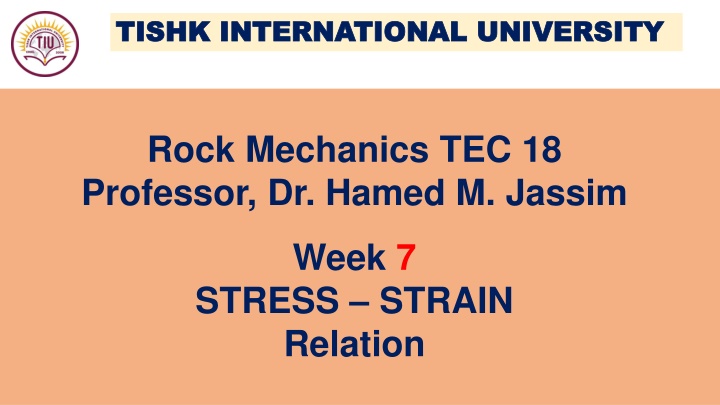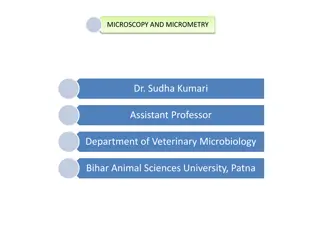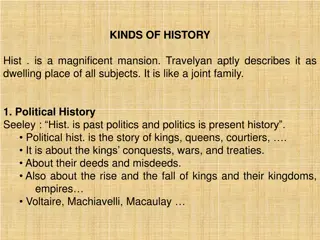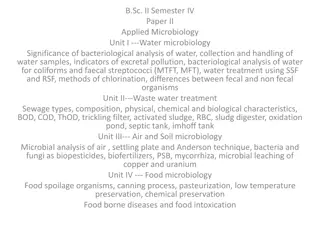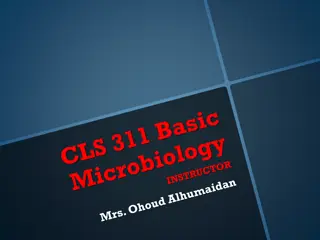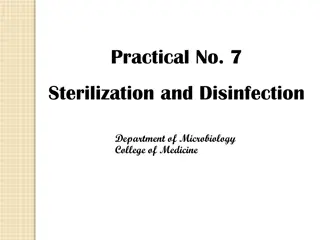Fascinating Journey Through Microbiology History
Unearth the captivating history of microbiology, from ancient Egyptian mummies harboring bacteria to Robert Hooke's cell theory, Anton van Leeuwenhoek's observations of live microorganisms, and the groundbreaking discoveries of the germ theory of disease and Koch's anthrax breakthrough. Explore how these milestones shaped our understanding of microscopic life forms, pathogens, and infectious diseases.
Download Presentation

Please find below an Image/Link to download the presentation.
The content on the website is provided AS IS for your information and personal use only. It may not be sold, licensed, or shared on other websites without obtaining consent from the author.If you encounter any issues during the download, it is possible that the publisher has removed the file from their server.
You are allowed to download the files provided on this website for personal or commercial use, subject to the condition that they are used lawfully. All files are the property of their respective owners.
The content on the website is provided AS IS for your information and personal use only. It may not be sold, licensed, or shared on other websites without obtaining consent from the author.
E N D
Presentation Transcript
TISHK INTERNATIONAL UNIVERSITY TISHK INTERNATIONAL UNIVERSITY Rock Mechanics TEC 18 Professor, Dr. Hamed M. Jassim Week 7 STRESS STRAIN Relation
TISHK INTERNATIONAL UNIVERSITY TISHK INTERNATIONAL UNIVERSITY
TISHK INTERNATIONAL UNIVERSITY TISHK INTERNATIONAL UNIVERSITY Hooke's Hooke's law: I Is s a principle of physics that states that a principle of physics that states that T The he force (F) needed to extend or force (F) needed to extend or compress a spring by some distance x scales compress a spring by some distance x scales linearly with respect to that linearly with respect to that distance . law: distance .
TISHK INTERNATIONAL UNIVERSITY TISHK INTERNATIONAL UNIVERSITY For linear springs For linear springs Consider a simple helical spring that has one end Consider a simple helical spring that has one end attached to some fixed object, while the free attached to some fixed object, while the free end is being pulled by a force whose magnitude end is being pulled by a force whose magnitude is is Fs Fs. . Suppose Suppose that the spring has reached a state of that the spring has reached a state of equilibrium, where its length is not changing equilibrium, where its length is not changing anymore. anymore.
TISHK INTERNATIONAL UNIVERSITY TISHK INTERNATIONAL UNIVERSITY Let Let x x be the amount by which the free end of the be the amount by which the free end of the spring was displaced from its "relaxed" position spring was displaced from its "relaxed" position (when it is not being stretched). (when it is not being stretched). Hooke's law states that: Hooke's law states that: Fs Fs= = kx kx or or, equivalently, , equivalently, x x = Fs/ k = Fs/ k where where k k is a positive real number, characteristic is a positive real number, characteristic of the spring. of the spring.
TISHK INTERNATIONAL UNIVERSITY TISHK INTERNATIONAL UNIVERSITY Moreover, the same formula holds when the spring is compressed, with Fs and x both negative in that case. According to this formula, the graph of the applied force Fs as a function of the displacement x will be a straight line passing through the origin, whose slope is k.
TISHK INTERNATIONAL UNIVERSITY TISHK INTERNATIONAL UNIVERSITY
TISHK INTERNATIONAL UNIVERSITY TISHK INTERNATIONAL UNIVERSITY Vector formulation In the case of a helical spring that is stretched or compressed along its axis, the applied (or restoring) force and the resulting elongation or compression have the same direction (which is the direction of said axis). Therefore, if F and x are defined as vectors, Hooke's equation still holds and says that the force vector is the elongation vector multiplied by a fixed scalar.
TISHK INTERNATIONAL UNIVERSITY TISHK INTERNATIONAL UNIVERSITY General tensor form Some elastic bodies will deform in one direction when subjected to a force with a different direction. One example is a horizontal wood beam with non-square rectangular cross section that is bent by a transverse load that is neither vertical nor horizontal. In such cases, the magnitude of the displacement x will be proportional to the magnitude of the force F, as long as the direction of the latter remains the same (and its value is not too large); so the scalar version of Hooke's law Fs = - kx will hold.
TISHK INTERNATIONAL UNIVERSITY TISHK INTERNATIONAL UNIVERSITY Hooke's equation holds (to some extent) in many other situations where an elastic body is deformed, such as wind blowing on a tall building. An elastic body or material for which this equation can be assumed is said to be linear-elastic or Hookean. Many materials will noticeably deviate from Hooke's law well before those elastic limits are reached.
TISHK INTERNATIONAL UNIVERSITY TISHK INTERNATIONAL UNIVERSITY On the other hand, Hooke's law is an accurate approximation for most solid bodies, as long as the forces and deformations are small enough. For this reason, Hooke's law is extensively used in all branches of science and engineering, and is the foundation of many disciplines such as seismology, molecular mechanics.
TISHK INTERNATIONAL UNIVERSITY TISHK INTERNATIONAL UNIVERSITY Hooke's law is only a first-order linear approximation to the real response of springs and other elastic bodies to applied forces. It must eventually fail once the forces exceed some limit, since no material can be compressed beyond a certain minimum size, or stretched beyond a maximum size, without some permanent deformation or change of state.
TISHK INTERNATIONAL UNIVERSITY TISHK INTERNATIONAL UNIVERSITY However, the force and displacement vectors will not be scalar multiples of each other, since they have different directions. Moreover, the ratio k between their magnitudes will depend on the direction of the vector Fs
TISHK INTERNATIONAL UNIVERSITY TISHK INTERNATIONAL UNIVERSITY The modern theory of elasticity generalizes Hooke's law to say that the strain (deformation) of an elastic object or material is proportional to the stress applied to it.
TISHK INTERNATIONAL UNIVERSITY TISHK INTERNATIONAL UNIVERSITY One example is a horizontal wood beam with non-square rectangular cross section that is bent by a transverse load that is neither vertical nor horizontal. In such cases, the magnitude of the displacement x will be proportional to the magnitude of the force Fs, as long as the direction of the latter remains the same (and its value is not too large); so the scalar version of Hooke's law Fs = kx will hold.
TISHK INTERNATIONAL UNIVERSITY TISHK INTERNATIONAL UNIVERSITY However, the force and displacement vectors will not be scalar multiples of each other, since they have different directions. Moreover, the ratio k between their magnitudes will depend on the direction of the vector Fs.
TISHK INTERNATIONAL UNIVERSITY TISHK INTERNATIONAL UNIVERSITY Yet, in such cases there is often a fixed linear relation between the force and deformation vectors, as long as they are small enough. Namely, there is a function from vectors to vectors, such that F = (X), and ( X1 + X2) = (X1) + (X2) for any real numbers , and any displacement vectors X1, X2. Such a function is called a (second-order) tensor.
TISHK INTERNATIONAL UNIVERSITY TISHK INTERNATIONAL UNIVERSITY With respect to an arbitrary Cartesian coordinate system, the force and displacement vectors can be represented by 3 1 matrices of real numbers. Then the tensor connecting them can be represented by a 3 3 matrix of real coefficients, that, when multiplied by the displacement vector, gives the force vector:
TISHK INTERNATIONAL UNIVERSITY TISHK INTERNATIONAL UNIVERSITY
TISHK INTERNATIONAL UNIVERSITY TISHK INTERNATIONAL UNIVERSITY That is, for i = 1, 2, 3.
TISHK INTERNATIONAL UNIVERSITY TISHK INTERNATIONAL UNIVERSITY Therefore, Hooke's law F = X can be said to hold also when X and F are vectors with variable directions, except that the stiffness of the object is a tensor , rather than a single real number k.
TISHK INTERNATIONAL UNIVERSITY TISHK INTERNATIONAL UNIVERSITY Hooke's law for continuous media The stresses and strains of the material inside a continuous elastic material (such as a block of rubber, the wall of a boiler, or a steel bar) are connected by a linear relationship that is mathematically similar to Hooke's spring law, and is often referred to by that name.
TISHK INTERNATIONAL UNIVERSITY TISHK INTERNATIONAL UNIVERSITY However, the strain state in a solid medium around some point cannot be described by a single vector. The same parcel of material, no matter how small, can be compressed, stretched, and sheared at the same time, along different directions. Likewise, the stresses in that parcel can be at once pushing, pulling, and shearing.
TISHK INTERNATIONAL UNIVERSITY TISHK INTERNATIONAL UNIVERSITY In order to capture this complexity, the relevant state of the medium around a point must be represented by two-second-order tensors, the strain tensor (in lieu of the displacement X) and the stress tensor (replacing the restoring force F).
TISHK INTERNATIONAL UNIVERSITY TISHK INTERNATIONAL UNIVERSITY The analogue of Hooke's spring law for continuous media is then = - c where c is a fourth-order tensor (that is, a linear map between second-order tensors) usually called the stiffness tensor or elasticity tensor. One may also write it as = - s where the tensor s, called the compliance tensor, represents the inverse of said linear map.
TISHK INTERNATIONAL UNIVERSITY TISHK INTERNATIONAL UNIVERSITY In a Cartesian coordinate system, the stress and strain tensors can be represented by 3 3 matrices:
TISHK INTERNATIONAL UNIVERSITY TISHK INTERNATIONAL UNIVERSITY Being a linear mapping between the nine numbers ij and the nine numbers kl, the stiffness tensor c is represented by a matrix of 3 3 3 3 = 81 real numbers cijkl. Hooke's law then says that
TISHK INTERNATIONAL UNIVERSITY TISHK INTERNATIONAL UNIVERSITY where i,j = 1,2,3.
TISHK INTERNATIONAL UNIVERSITY TISHK INTERNATIONAL UNIVERSITY Tensional stress of a uniform bar A rod of any elastic material may be viewed as a linear spring. The rod has length L and cross-sectional area A. Its tensile stress is linearly proportional to its fractional extension or strain by the modulus of elasticity E: s = E
TISHK INTERNATIONAL UNIVERSITY TISHK INTERNATIONAL UNIVERSITY The modulus of elasticity may often be considered constant. In turn, (that is, the fractional change in length), and since it follows that:
TISHK INTERNATIONAL UNIVERSITY TISHK INTERNATIONAL UNIVERSITY The change in length may be expressed as
TISHK INTERNATIONAL UNIVERSITY TISHK INTERNATIONAL UNIVERSITY
TISHK INTERNATIONAL UNIVERSITY TISHK INTERNATIONAL UNIVERSITY
TISHK INTERNATIONAL UNIVERSITY TISHK INTERNATIONAL UNIVERSITY
TISHK INTERNATIONAL UNIVERSITY TISHK INTERNATIONAL UNIVERSITY
TISHK INTERNATIONAL UNIVERSITY TISHK INTERNATIONAL UNIVERSITY
